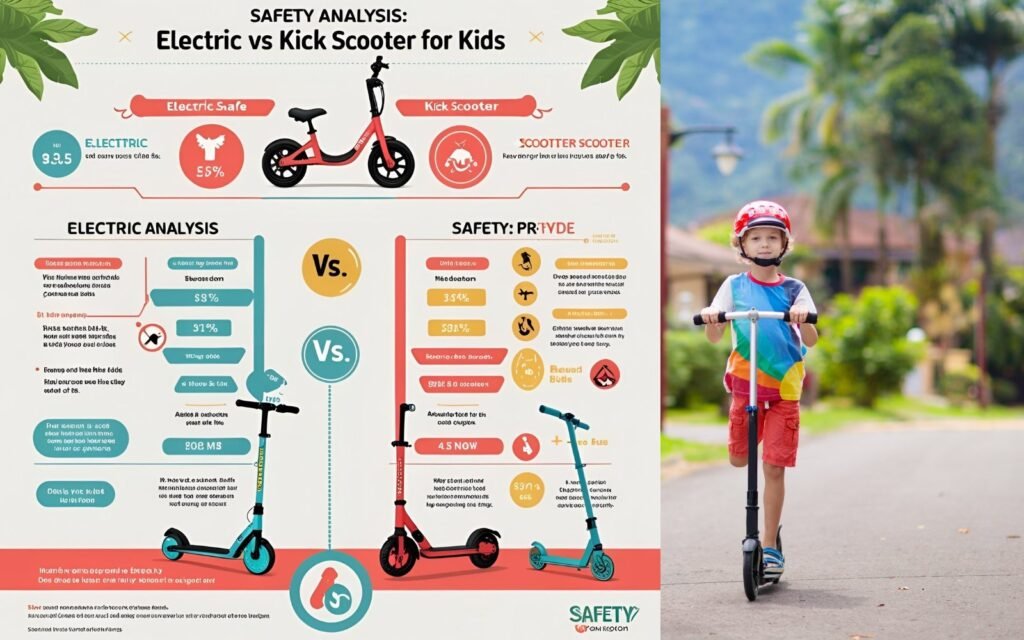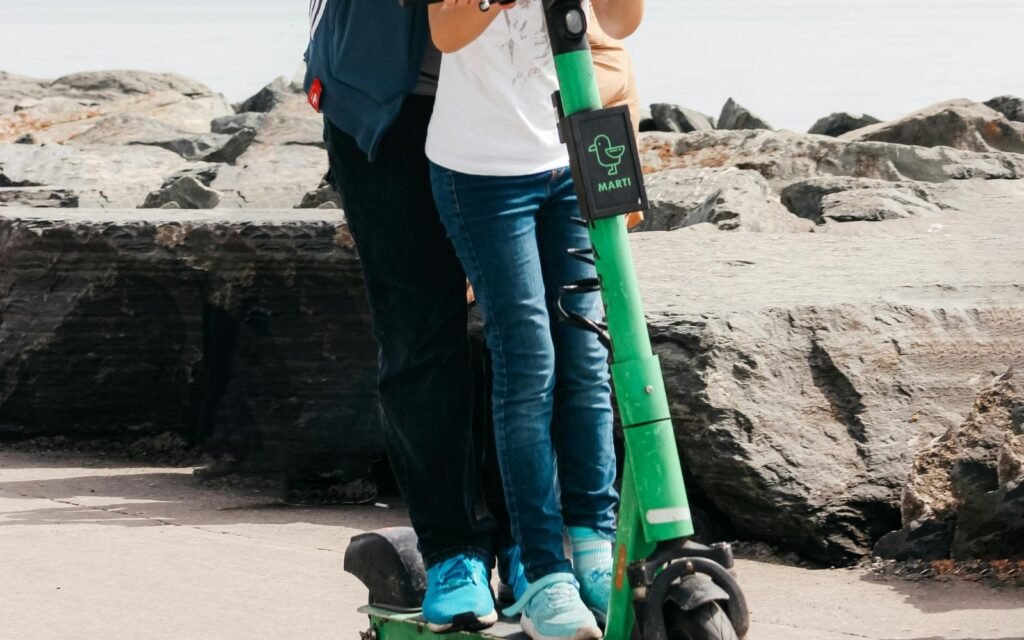Electric vs Kick Scooter for Kids: The Ultimate Parent’s Helpful Comparison Guide in 2025

Nearly 68% of parents struggle with the decision between electric vs kick scooter for kids, according to recent market research by the Consumer Product Safety Commission. This seemingly simple choice has become increasingly complex as electric scooters gain popularity while traditional kick scooters maintain their appeal for developing fundamental riding skills.
The challenge extends beyond just cost considerations. Parents must weigh safety concerns, developmental benefits, environmental impact, and long-term value when making this decision. Add in factors like age appropriateness, maintenance requirements, and storage needs, and the choice becomes even more nuanced.
This comprehensive comparison will help you navigate the electric vs kick scooter for kids debate with confidence. Having tested both types extensively with children ranging from 5 to 15 years old, and consulting with pediatric development specialists, I’ll provide the insights you need to make the best choice for your family’s specific needs and circumstances.
Key Takeaways – Electric vs Kick Scooter for Kids
- Kick scooters excel at developing balance, coordination, and physical fitness while electric scooters offer convenience and extended range
- Age and developmental stage significantly influence which option provides better value and safety for individual children
- Electric scooters require higher upfront investment and ongoing maintenance, while kick scooters offer simpler, more affordable operation
- Safety considerations differ dramatically between the two options, with each presenting unique risks and protective requirements
Understanding the Core Differences in Electric vs Kick Scooter for Kids

Power Source and Operation
The fundamental distinction in the electric vs kick scooter for kids comparison lies in propulsion methods. Kick scooters rely entirely on human power, requiring children to push off the ground with one foot while balancing on the deck with the other.
Electric scooters use battery-powered motors to provide propulsion, allowing riders to simply twist a throttle or push a button to accelerate. This difference affects everything from skill development to safety considerations.
The motor assistance in electric scooters can help children travel longer distances and tackle hills that would be challenging on kick scooters. However, this convenience comes at the cost of reduced physical exercise and potentially faster speeds that may exceed a child’s ability to react safely.
Speed and Control Capabilities
When comparing electric vs kick scooter for kids in terms of speed, electric models typically reach 8-15 mph, while kick scooters rarely exceed 5-8 mph even with experienced riders on downhills. This speed difference has significant safety implications for young riders.
Kick scooters offer more intuitive speed control since children must actively propel themselves. They naturally slow down when tired and can easily control their pace through push frequency and force.
Electric scooters require more sophisticated understanding of throttle control and braking systems. While many models include speed limiting features, the potential for sudden acceleration or difficulty controlling speed remains a concern for younger children.
Age-Appropriate Considerations for Electric vs Kick Scooter for Kids

Developmental Stage Requirements
The electric vs kick scooter for kids decision should heavily consider developmental readiness. Children aged 3-6 typically lack the motor planning skills and impulse control necessary for safe electric scooter operation.
Kick scooters can be appropriate for children as young as 2-3 years old with proper supervision, as they promote natural balance development and allow gradual skill progression. The self-limiting nature of kick scooters makes them inherently safer for younger children.
Electric scooters are generally recommended for children 8 years and older, though individual maturity levels vary significantly. The ability to understand cause-and-effect relationships with throttle control becomes crucial for safe operation. For more insights on age-appropriate activities, consider reading about safe outdoor play ideas for toddlers.
Physical Development Benefits
From a physical development perspective, the electric vs kick scooter for kids comparison heavily favors traditional kick scooters. The pushing motion required for kick scooters develops leg strength, cardiovascular fitness, and core stability.
Kick scooters also enhance proprioception (body awareness) and balance through the constant micro-adjustments required to maintain forward momentum. These skills transfer to other activities like cycling, skateboarding, and general athletic performance. Learn more about encouraging independent play and how physical activities support child development.
Electric scooters provide minimal physical exercise beyond balance maintenance, potentially contributing to sedentary lifestyle habits if they replace more active transportation methods.
Cognitive and Motor Skill Development
The learning curve for kick scooters naturally develops important motor planning and coordination skills. Children must coordinate pushing, steering, and balancing simultaneously, creating valuable neural pathways for complex movement patterns.
Electric scooters require different cognitive skills, including understanding of mechanical systems, battery management, and more complex decision-making about speed and braking. While these skills have value, they don’t necessarily translate to physical development benefits.
The instant gratification of electric scooters may also impact patience and persistence development that comes naturally with mastering kick scooter techniques. Understanding building resilience in young children can help parents make better decisions about activities that support character development.
Safety Analysis: Electric vs Kick Scooter for Kids

Injury Risk Patterns
Safety statistics reveal different injury patterns when comparing electric vs kick scooter for kids. Kick scooter injuries typically involve minor scrapes, bruises, and occasional wrist fractures from falls at lower speeds.
Electric scooter injuries tend to be more severe due to higher speeds and the potential for mechanical failures. Emergency room data shows increased rates of head injuries, facial trauma, and more serious fractures among electric scooter users.
The Consumer Product Safety Commission reports that electric scooter injuries have increased 222% among children over the past five years, while kick scooter injury rates have remained relatively stable.
Environmental Hazard Response
In the electric vs kick scooter for kids safety comparison, response to environmental hazards differs significantly. Kick scooter riders can quickly step off their scooter when encountering obstacles, using natural reflexes developed through walking and running.
Electric scooter riders may struggle to react quickly enough to obstacles, particularly when traveling at higher speeds. The need to coordinate braking, steering, and potentially dismounting requires more complex decision-making under pressure.
Weather conditions also affect safety differently. Wet surfaces pose significant risks for electric scooters due to reduced braking effectiveness and potential electrical issues, while kick scooters simply require more careful pushing technique.
Protective Equipment Requirements
Helmet requirements remain consistent in the electric vs kick scooter for kids comparison, but additional protective gear becomes more important for electric scooter use. Knee and elbow pads, once considered optional for kick scooters, become highly recommended for electric models.
The higher speeds possible with electric scooters may warrant additional protection like wrist guards and more robust helmet designs. Some safety experts recommend motorcycle-style protective gear for electric scooter use, particularly for older children or high-performance models. For parents interested in motorcycle safety for kids, check out information on how to teach your child to ride a motorcycle and are motorcycles safe for kids.
Visibility equipment also becomes more crucial for electric scooter users who may venture further from home and potentially ride during lower-light conditions.
Financial Considerations in Electric vs Kick Scooter for Kids

Initial Investment Comparison
The upfront cost difference in electric vs kick scooter for kids purchases is substantial. Quality kick scooters range from $30-200, while comparable electric scooters typically cost $150-600 or more.
Budget-conscious families often find kick scooters more accessible, especially when purchasing for multiple children. The lower initial investment also reduces financial stress if the scooter is damaged, lost, or outgrown quickly.
However, the cost-per-use calculation may favor electric scooters for families who use them frequently for transportation rather than just recreation. For budget-conscious parents, explore setting up a nursery on a budget for more money-saving tips.
Long-Term Ownership Costs
Ongoing expenses heavily favor kick scooters in the electric vs kick scooter for kids financial analysis. Kick scooters require minimal maintenance beyond occasional wheel replacement and basic cleaning.
Electric scooters involve battery replacement costs ($50-150 every 1-3 years), charging expenses, and more complex mechanical repairs. Software updates, motor maintenance, and electronic component failures add to long-term ownership costs.
Insurance considerations may also apply to electric scooters, particularly for higher-end models or in areas with specific liability concerns.
Value Retention and Resale
Kick scooters generally retain value better in the electric vs kick scooter for kids resale market. Simple mechanical systems age gracefully, and quality kick scooters can serve multiple children over many years.
Electric scooters face technology obsolescence, battery degradation, and software compatibility issues that reduce resale value significantly. The rapid pace of electric scooter innovation means models become outdated quickly.
Consider the total cost of ownership over the expected usage period when making financial decisions between the two options.
Practical Usage Scenarios

Daily Transportation vs Recreation
The electric vs kick scooter for kids decision often depends on intended use patterns. Electric scooters excel for longer commutes to school or activities where distance and hills make kick scooters impractical.
Kick scooters work well for neighborhood exploration, short trips to friends’ houses, and recreational riding where the journey itself provides entertainment and exercise. For families who travel frequently, consider reading about travel essentials for baby’s first trip for comprehensive travel planning.
Consider your family’s typical transportation needs and whether the scooter will supplement or replace other forms of transportation like walking, cycling, or car rides.
Storage and Portability
Both options offer advantages in the electric vs kick scooter for kids portability comparison. Kick scooters are generally lighter and simpler to carry when folded, making them easier for children to manage independently.
Electric scooters often include more sophisticated folding mechanisms but weigh significantly more due to batteries and motors. This weight difference affects whether children can carry their scooters upstairs, into buildings, or for extended periods.
Storage space requirements are similar when folded, though electric scooters may require access to charging outlets and climate-controlled environments for battery longevity. For space-saving storage solutions, explore small nursery ideas for creative organization tips.
Weather and Seasonal Considerations
Climate significantly impacts the electric vs kick scooter for kids usability equation. Electric scooters face limitations in wet conditions due to electrical components and reduced braking effectiveness.
Cold weather affects battery performance in electric scooters, reducing range and potentially causing operational issues. Kick scooters operate consistently across temperature ranges with only minor performance variations.
Seasonal storage requirements differ as well, with electric scooters needing battery maintenance during extended storage periods while kick scooters can be stored with minimal preparation.
Making the Right Choice for Your Family

Assessment Framework
Use a systematic approach when weighing electric vs kick scooter for kids options. Consider your child’s age, maturity level, physical development needs, and intended usage patterns.
Evaluate your family’s budget not just for initial purchase but for ongoing costs including maintenance, protective equipment, and potential replacements. Factor in storage space, charging capabilities, and local regulations that may affect usage.
Consider starting with a kick scooter and potentially transitioning to electric models as children mature and demonstrate responsible riding habits. For more guidance on effective parenting decisions, read about effective time management for parents.
Trial and Testing Opportunities
Many retailers offer opportunities to test both options before making the electric vs kick scooter for kids decision. Take advantage of these chances to assess your child’s comfort level and natural aptitude with each type.
Some rental companies or community programs allow extended trials that provide better insight into long-term satisfaction and usage patterns. This approach can prevent costly mistakes and ensure the final choice matches your family’s actual needs.
Practical Takeaways
- Start with kick scooters for children under 8 to develop fundamental balance and coordination skills before considering electric options
- Factor in total cost of ownership including maintenance, protective gear, and replacement parts when comparing options
- Prioritize safety features and age-appropriate speed limits regardless of which type you choose
- Consider your local environment, storage capabilities, and intended usage patterns when making the final decision
- Test both options when possible to assess your child’s comfort level and natural aptitude before purchasing
Summary
The electric vs kick scooter for kids decision ultimately depends on your family’s specific needs, budget, and safety priorities. While electric scooters offer convenience and extended range, kick scooters provide superior developmental benefits and lower-risk operation for most children.
Consider starting with a quality kick scooter to build fundamental skills, then potentially upgrading to electric models as children mature and demonstrate responsible riding habits. This progression approach maximizes safety while allowing children to experience both options.
Take time to assess your child’s readiness, evaluate your budget comprehensively, and test options when possible. Share your own experiences with scooter selection in the comments below, and consider how your insights might help other parents navigate this important decision.
FAQs About Electric vs Kick Scooter for Kids
What age is appropriate for switching from kick to electric scooters?
- Most children are ready for electric scooters around age 8-10 with proper supervision
- Maturity level matters more than chronological age for safe electric scooter operation
- Children should demonstrate consistent safety habits on kick scooters first
- Consider starting with low-speed electric models before advancing to full-featured options
How do safety risks compare between electric vs kick scooter for kids?
- Kick scooters generally result in less severe injuries due to lower speeds
- Electric scooters pose higher risks but offer better control features like hand brakes
- Both require helmets, but electric scooters may warrant additional protective gear
- Proper training and supervision significantly reduce risks for both types
What are the main cost differences in electric vs kick scooter for kids ownership?
- Kick scooters cost $30-200 initially with minimal ongoing expenses
- Electric scooters range from $150-600+ with battery replacement and maintenance costs
- Long-term ownership favors kick scooters due to simpler mechanical systems
- Consider total cost over expected usage period when making budget decisions
Which option provides better exercise benefits for children?
- Kick scooters offer significantly more physical exercise through pushing motion
- Electric scooters provide minimal cardiovascular benefits beyond balance training
- Kick scooters develop leg strength, core stability, and coordination skills
- Consider electric scooters if they replace car rides rather than active transportation
Can children transition easily between electric vs kick scooter for kids?
- Most children adapt quickly from kick to electric scooters
- Transitioning from electric back to kick scooters may require adjustment period
- Basic balance and steering skills transfer between both types
- Start with kick scooters to build fundamental skills before introducing electric options
